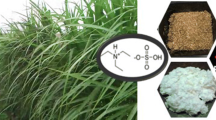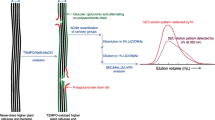Abstract
Softwood cellulose pulp was oxidized by a two-step oxidation process with sodium periodate followed by sodium chlorite at pH 5.0. The oxidized product was first separated into two fractions by centrifugation, and the supernatant was further separated in two fractions by addition of ethanol and centrifugation. Different levels of oxidation were performed on cellulose, and the mass ratio and carboxyl content of each fraction were determined. The first precipitate, which amount decreases with increasing oxidation level, consists of short fiber fragments (microfibrils) with length of 0.6–1.8 μm and width around 120 nm, which for sufficiently high oxidation levels, could readily be made into cellulose nanofibrils by stirring. The second precipitate (after alcohol addition) has a very high crystalline index of 91 % and contains rod-like particles with length of 120–200 nm and diameter around 13 nm, reminiscent of nanocrystalline cellulose. The supernatant contains water-soluble dicarboxylated cellulose, as proven by liquid C-13 NMR.











Similar content being viewed by others
References
Alam MN, Antal M, Tejado A, van de Ven TGM (2012) Salt-induced acceleration of chemical reactions in cellulose nanopores. Cellulose 19(2):517–522
Araki J, Wada M, Kuga S (2001) Steric stabilization of a cellulose microcrystal suspension by poly(ethylene glycol) grafting. Langmuir 17:21–27
Bruneel D, Schacht E (1993) Chemical modification of pullulan: 1. Periodate oxidation. Polymer 34:2628–2632
Chavan VB, Sarwade BD, Varma AJ (2002) Morphology of cellulose and oxidised cellulose in powder form. Carbohydr Polym 50:41–45
Dong XM, Gray DG (1997) Effect of counterions on ordered phase formation in suspensions of charged rodlike cellulose crystallites. Langmuir 13:2404–2409
Dong XM, Revol JF, Gray DG (1998) Effect of microcrystallite preparation conditions on the formation of colloid crystals of cellulose. Cellulose 5(1):19–32
Duchemin B, Newman R, Staiger M (2007) Phase transformations in microcrystalline cellulose due to partial dissolution. Cellulose 14:311–320
Elazzouzi-Hafraoui S, Putaux JL, Heux L (2009) Self-assembling and chiral nematic properties of organophilic cellulose nanocrystals. J Phys Chem B 113(32):11069–11075
Hofreiter BT, Wolff IA, Mehltretter L (1957) Chlorous acid oxidation of periodate oxidized cornstarch. J Am Chem Soc 79:6457–6460
Hou QX, Liu W, Liu ZH, Bai LL (2007) Characteristics of wood cellulose fibers treated with periodate and bisulfite. Ind Eng Chem Res 46:7830–7837
Huang B, van de Ven TGM, Hill RJ (2011) Electro - optics of polymer nanotube dispersions. J Phys Chem C 115:8447–8456
Isogai A, Usuda M, Kato T, Uryu T, Atalla RH (1989) Solid-state CP/MAS carbon-13 NMR study of cellulose polymorphs. Macromolecules 22:3168–3172
Keshk SMAS (2008) Homogenous reactions of cellulose from different natural sources. Carbohydr Polym 74:942–945
Kim UJ, Kuga S, Wada M, Okano T, Kondo T (2000) Periodate oxidation of crystalline cellulose. Biomacromolecules 1:488–492
Kim UJ, Wada M, Kuga S (2004) Solubilization of dialdehyde cellulose by hot water. Carbohydr Polym 56:7–10
Maekawa E, Koshijima T (1984) Properties of 2,3-dicarboxy cellulose combined with various metallic ions. J Appl Polym Sci 29(7):2289–2297
Nishiyama Y, Langan P, Chanzy H (2002) Crystal structure and hydrogen-bonding system in cellulose Iâ from synchrotron X-ray and neutron fiber diffraction. J Am Chem Soc 124:9074–9082
Nisizawa K (1973) Mode of action of celluloses. J Ferment Technol 51:267–304
Rolande B, Agnese M, Marco C (2000) Swelling behavior of carboxymethylcellulose hydrogels in relation to cross-linking, pH, and charge density. Macromolecules 33:7475–7480
Rutherford HA, Minor FW, Martin AR, Harris M (1942) Oxidation of cellulose: the reaction of cellulose with periodic acid. J Res Nat Bur Stand 29:131–140
Saito T, Hirota M, Tamura N, Isogai A (2010) Oxidation of bleached wood pulp by TEMPO/NaClO/NaClO2 system: effect of the oxidation conditions on carboxylate content and degree of polymerization. J Wood Sci 56(3):227–232
Schumacher GA, van de Ven TGM (1991) Brownian motion of rod-shaped colloidal particles surrounded by electrical double layers. J Chem Soc, Faraday Trans 87(7):971–976
Segal L, Creely JJ, Martin AE, Conrad CM (1959) An empirical method for estimating the degree of crystallinity of native cellulose using the X-Ray diffractometer. Textile Res J 29:786–794
Staudinger H (1920) Über polymerisation. Ber Dtsch Chem Ges 53:1073–1085
Tejado A, Alam MN, Antal M, Yang H, van de Ven TGM (2012) Energy requirements for the disintegration of cellulose fibers into cellulose nanofibers. Cellulose 19(3):831–842
Varma AJ, Chavan VB (1995a) A study of crystallinity changes in oxidised celluloses. Polym Degrad Stab 49:245–250
Varma AJ, Chavan VB (1995b) Thermal properties of oxidized cellulose. Cellulose 2:41–49
Varma AJ, Chavan VB, Rajmohanan PR, Ganapathy S (1997) Some observations on the high-resolution solid-state CP-MAS 13C-NMR spectra of periodate-oxidised cellulose. Polym Degrad Stab 58:257–260
Yang H, Tejado A, Alam MN, van de Ven TGM (2012) Films prepared from electrosterically stabilized nanocrystalline cellulose. Langmuir 28(20):7834–7842
Yuen SN, Choi SM, Phillips DL, Ma CY (2009) Raman and FTIR spectroscopic study of carboxymethylated non-starch polysaccharides. Food Chem 114:1091–1098
Acknowledgments
This work was performed as part of NSERC Industrial Research Chair program, funded by NSERC and FPInnovations.
Author information
Authors and Affiliations
Corresponding author
Rights and permissions
About this article
Cite this article
Yang , H., Alam, M.N. & van de Ven, T.G.M. Highly charged nanocrystalline cellulose and dicarboxylated cellulose from periodate and chlorite oxidized cellulose fibers. Cellulose 20, 1865–1875 (2013). https://doi.org/10.1007/s10570-013-9966-7
Received:
Accepted:
Published:
Issue Date:
DOI: https://doi.org/10.1007/s10570-013-9966-7




